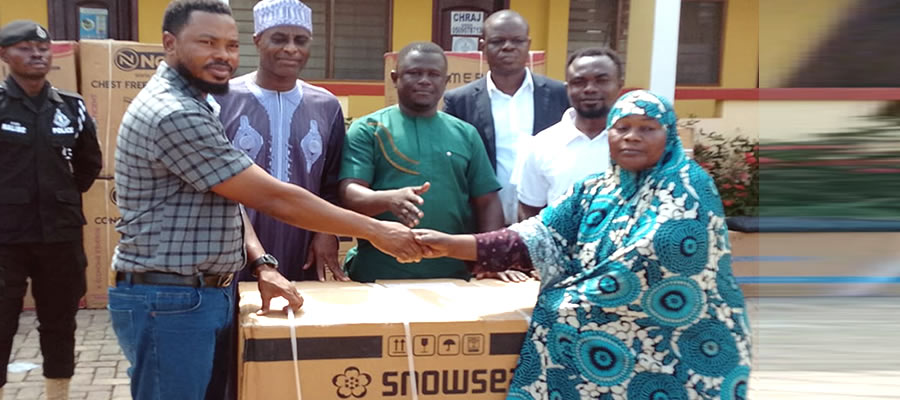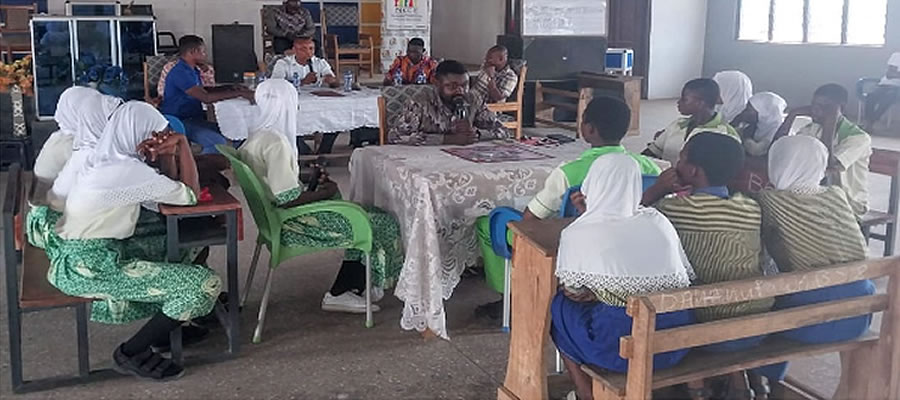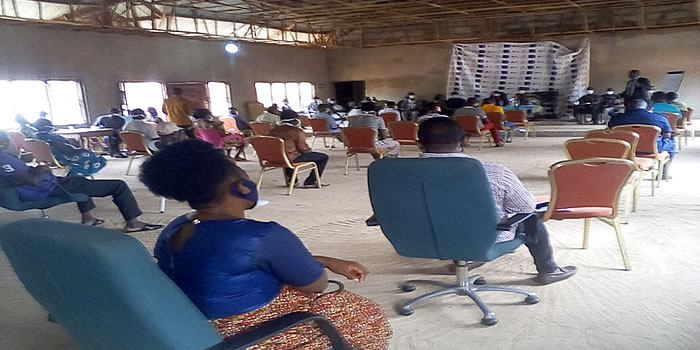

INFORMATION AND COMMUNICATION TECHNOLOGY (ICT)
We live in an information world therefore knowledge in ICT will enhance the socio-economic development of the District. The district has no a single ICT expert to facilitate easy leaning of the teeming youth. It will be expedient for the district to support students that will be pursuing ICT programs at various tertiary schools in order to get ICT experts in the district. There are only three (3) internet cafes in the District which are mostly accessed by a few number of the population. Due to the high illiteracy rate, these internet cafes are not well patronized compared to the use of Mobile Phones. As indicated earlier the District is yet to benefit from the Community Information Centre (CIC) drive of the Government (Ministry of Communication) which was to make internet facilities more affordable to communities who barely have them. Also, there are a handful of people who use ICT for retrieval, storage of and management of data with the advent of internet modems.
In terms of communication, six out of ten people have access to Mobile Phones and even own them. The use of the device does not need any special training, thus the high patronage. The use of mobile phones in the district is now more or less a necessity rather than, luxury as it was perceived some years back.
POVERTY, INEQUALITY AND SOCIAL PROTECTION
The income levels of the households in the district vary widely. This is because there is a mix of very high income earners as well as very low income earners. The average annual income for an average household size (4 people) is about GH¢782.45. This translates into an average per capital annual income of GH¢195.61
Sixty-six (66%) of the people earn their income from agriculture related activities, seventeen (17%) from the Service Sector, 13% commerce and 4% industry. Income levels are generally low throughout the district as compared to the national average income for head of $390.00. This therefore calls for prudent measures to develop the major sectors of the local economy, especially agriculture and other related activities through effective storage, processing and marketing of produce and support to the private sector which is now considered as the engine of growth of every economy.
As an agricultural economy supported by a vibrant fishing industry, like the Pru West District, it is critical to encourage people to produce enough for local consumption and export the surplus thus cutting down expenditure on food. This is the easiest way for people to save towards developments.
A general overview of the household income shows that, there are high inequalities in the distribution of income in the district. It could be found that, the wealth in the district is in the possession of a few people who form only about 18% of the entire population of the district and this indeed is a typical characteristics of a developing country. The remaining 72% forms average income earners and the extreme poor who cannot afford three square meals a day (mostly in rural areas).
As an agrarian district, the population of self-employed without employees is high, about 70.9 % with unpaid family workers of 16.2%. This invariably means that when the agricultural sector is affected, the capacity of the local economy is equally affected, hence affect future employment. Majority of the self-employed are engaged in small-scale economic enterprises such as fish processing, dressmaking/tailoring, artisan work, auto-repairs services, hairdressing and food processing. Many people are also subsistence farmers engaged in subsistence agriculture. However, most of the self-employed in the private informal sector have not registered their businesses either at the Registrar General Department or with the Assembly. Efforts need to be made to sensitize them on the need to register their businesses and the opportunities available to them at the various financial institutions to increase their capital base
Access to and Control over Resources and Benefits
Gender roles also affect how men and women have access to and control over resources, benefits and decision-making. Having access means having the opportunity to use a resource or influence a decision but it does not mean having control over it.
Productive, reproductive and community management roles all require the use resources. Availability of resources to women engaged in work usually generates benefits for individuals, households, the communities and the District at large.
The gender and development approach to development requires sensitivity to women?s access to the resources needed for their work, their control over those resources to use as they wish, their access to the benefits gained from family and personal work, and to the control they have over the benefits.
Resources such as land, equipment, tools, labour, cash/credit, employable/income earning skills, employment, leadership, education and information, self-confidence and credibility and time are generally critical but scarce for women.
In the District, women have access to most of the resources they use to perform their roles, but no control over them. For instance, women have access to land, food, income, local political processes but no control over ownership, its allocation, how it can be spent and little influence and control over the nature of issues to be addressed and final decisions.
A study conducted reveals that access to and control of the District resources is skewed towards men. However, further disaggregation of the data shows, women control most of the productive roles (petty trading, fish smoking etc) are dominated by women. The Assembly therefore has to promote these sub-sectors to help bridge the gap in other roles especially in community management roles and political roles.
Manufacturing Industries
The district has quite a number of people in the manufacturing industry (11.5%) of which 4.0 percent are males and 19.1 percent are females. Wholesale and retail; repair of motor vehicles and motorcycles is the third largest industry employing 11.4 percent. This is probably because the district has a vibrant market from which out-board motors for powering boats and canoes as well as motor vehicles and motor cycles for transporting of goods and materials to and from in the district are sold. The sector employs 5,726 people and is mostly dominated by females who constitute 17.1 percent with only 5.8 percent of them being males.
Energy
The major sources of energy for lighting in the communities in the District are Electricity (38.5%), Kerosene (27.1%), Flashlight/Torch light (33%) and Firewood (0.5%), Candles are however not in use. That for looking on the other hand includes firewood (64.8%), charcoal (31%) with other sources recording minimal figures in energy for cooking. Table 1.7 below illustrates the various sources of energy.
The persistent power outage (electricity main), inadequate supply and high cost of fuel for cooking and high poverty levels are some of the challenges mitigating against the use of environmentally friendly energy sources especially for cooking. The construction of a substation at Atebubu to serve surrounding districts will remedy the frequent power outages and boost small scale industries especially the Cold store operators, welding operators among others.
Oil and Gas
Pru West is one of the 32 identified districts for the potential onshore oil and gas exploration and development along the voltaian basin by SEA carried out by the Environmental Protection Agency. GNPC and relevant stakeholders have started gathering seismic data and information along the basin for further analysis. This has the potential of opening up the district to both local and foreign migrants. The district will be confronted with several development challenges that will affect communities and livelihood positively and negatively.
Management in view of this has to take proactive measures to ensure that existing natural resources are not jeopardized in the quest to exploit the oil and gas. Adequate compensations, capacity building and sensitization ought to be seriously considered among the local people in order to reduce its impact.
SCIENCE, TECHNOLOGY AND INNOVATION (STI)
Science, technology and innovation (STI) are key drivers of economic and social development. The experience of successful developing countries shows that STI policies that are well integrated into national development strategies and combined with institutional and organizational changes can help raise productivity, improve firm competitiveness, support faster growth and create jobs.
To achieve this, policies need to address the specific features of innovation in developing countries. Examples include the weight of traditional sectors in the district, the importance of incremental and adaptive innovation, the need to identify, acquire and adapt foreign innovations, the particular role of foreign direct investment, the limited access of firms to skilled workers and to capital, weak technology-related infrastructure and inadequate intellectual property rights regimes.
STI policy for development focuses on supporting the integration of STI in district development strategies and building-up STI policy-making capacity in the district. As an Agrarian District with climate change at hand, to ensure food security in order to feed the growing population we need to adapt STI to increase production in the district. This can be done through the introduction of improved seed variety and drought resistant crops that will sustain the agriculture sector of the district.
SCIENCE, TECHNOLOGY AND INNOVATION (STI)
Science, technology and innovation (STI) are key drivers of economic and social development. The experience of successful developing countries shows that STI policies that are well integrated into national development strategies and combined with institutional and organizational changes can help raise productivity, improve firm competitiveness, support faster growth and create jobs.
To achieve this, policies need to address the specific features of innovation in developing countries. Examples include the weight of traditional sectors in the district, the importance of incremental and adaptive innovation, the need to identify, acquire and adapt foreign innovations, the particular role of foreign direct investment, the limited access of firms to skilled workers and to capital, weak technology-related infrastructure and inadequate intellectual property rights regimes. STI policy for development focuses on supporting the integration of STI in district development strategies and building-up STI policy-making capacity in the district.
As an Agrarian District with climate change at hand, to ensure food security in order to feed the growing population we need to adapt STI to increase production in the district. This can be done through the introduction of improved seed variety and drought resistant crops that will sustain the agriculture sector of the district.
Date Created : 7/14/2023 12:00:00 AM










 facebook
facebook
 twitter
twitter
 Youtube
Youtube
 +233 593 831 280
+233 593 831 280 0800 430 430
0800 430 430 GPS: GE-231-4383
GPS: GE-231-4383 info@ghanadistricts.com
info@ghanadistricts.com Box GP1044, Accra, Ghana
Box GP1044, Accra, Ghana